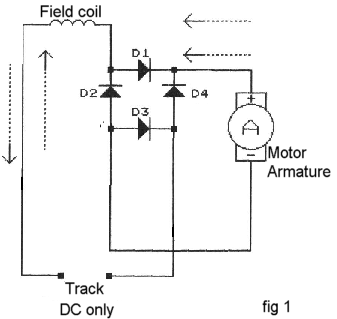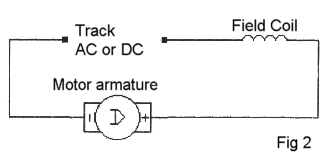This website has been archived from TrainWeb.org/s-trains to TrainWeb.US/s-trains.
| Modifying an A.C. Gilbert American Flyer
handcar for reverse Copyright@ 1999 by Alex Mendelsohn.
Permission to reproduce, with attribution, is freely granted for non-profit publication. At the 1998 Worcester NASG Convention, a gentleman told me that A.C. Gilbert offered a 740 Series S-gauge handcar that included a mechanical switch that reversed the motor when the handcar touched a spur bumper. Then and there I knew that the wormgear drive would work okay in reverse (prior to that I wasn't sure running it in reverse would be a good idea from a mechanical standpoint). The trick is to wire in what's called a bridge. The bridge "steers" the DC current flow through the handcar motor's armature. It is NOT used to convert AC to DC, which is the usual function of a bridge rectifier. |
Diode
configured wiring |
DC only please Once modified, you MUST run your handcar on DC. It will no longer work on AC-powered trackage. For me, that isn't a problem because my Putt Trains trolleys were already running on a DC traction line. I run the handcar on that dedicated track along with the trolleys. With the steering diodes installed, reversing the polarity (see fig 3) of the DC applied to the tracks (I use a DPDT switch for this purpose) reverses the handcar! By the way, the car runs nicely with pulsed DC from a modern HO power pack as well as "straight" DC. In any case, you have to use physically small diodes. I use diodes that are rated for 1 Ampere. The circuit is a bridge configuration electrically, but you'll make it up in a flexible physical shape that can be bent as needed to fit the small space inside the handcar. How does it work? Originally, the field and the armature were wired by Gilbert in series (see Fig 2). At any instant, the AC current would flow from the track, through the armature, then through the field coil, and back to the track. (Yes, the current reverses 60 times a second, but disregard that for the purpose of this discussion). In the original configuration, if you tried running the handcar on DC--as I did--and you reversed the polarity of the DC applied to the tracks in an effort to reverse the car's direction, the magnetic fields in BOTH the field coil and the armature coil would reverse magnetic polarity---and the motor would still run in the same direction. Disappointing. With diodes (see fig 1), the current in the field coil reverses when polarity to the tracks is reversed, BUT the current through the armature flows in the same direction as always. That means the motor can now run in reverse because the magnetic fields are either in concert, or in opposition. My diagram shows the current flows as arrows. They can help you understand how it happens. The key thing is that diodes are polarity sensitive, if you will, and only conduct DC flow on one direction. |
Original hand car wiring |
|
 |
| Keep it small Use individual small silicon power rectifier diodes to construct your four-diode bridge, rather than a fixed form-factor pre-wired rectifier unit which is typically made of an epoxy casting and is much larger. The diodes are garden variety silicon power types available from Radio Shack and catalog sources such as Digi-Key or Mouser. 1N4001 or 1N4002 types are fine. Place the diodes on your workbench and physically lay them out side by side with short leads. Plan ahead with an eye towards where they will sit inside the handcar housing. Observe the polarity markings on the diodes. The cathodes are banded--usually with a white stripe. The end without a stripe is called an anode. Silicon diodes are VERY heat resistant, so there's no need to worry about destroying them during soldering, although it pays to work quickly in any case. You don't need to use pliers or heat sink clamps though. Once the little "network" of diodes is soldered together, you can flex it as needed to make it fit near the motor. Use folds of tape as insulation, or heat shrink tubing. There's no bulky circuit board or mounting plate. There's no room for one inside the handcar! The diodes are supported by their leads. One wheel's pickup wire goes to the field. The other rail pickup wire goes to the point on the bridge where one cathode (marked end) and one anode (unmarked end of a diode) meet. The other side of the bridge (one marked diode end, one unmarked) gets wired to the other side of the field coil. The "+" side of the bridge (two cathodes) goes to one side of the armature. The "-" side of the bridge (two anodes) goes to the other side of the armature. That's all there is to it. Follow the wiring diagram. It doesn't matter which end of the armature you choose. The diodes steer the field current while the armature current direction stays the same---and---voila!-----you can reverse the direction. I was delighted to see my little handcar come alive and run in reverse or forward---after all these years---with modern solid-state electronics aboard! Good luck. Have fun! If you have questions, you can reach me by e-mail at <alex.ai2q@worldnet.att.net>. -- Alex Mendelsohn .-.-. |
Return to S-Trains or Return to Navigation Page Contact Paul Yorke
















